
Branford Center is a neighborhood and census-designated place (CDP) in the town of Branford, Connecticut, United States. The CDP encompasses the traditional town center area and the area known as Branford Point. The population of the CDP was 5,819 at the 2010 census.
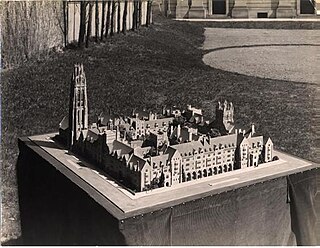
The Memorial Quadrangle is a residential quadrangle at Yale University in New Haven, Connecticut. Commissioned in 1917 to supply much-needed student housing for Yale College, it was Yale's first Collegiate Gothic building and its first project by James Gamble Rogers, who later designed ten other major buildings for the university. The Quadrangle has been occupied by Saybrook College and Branford College, two of the original ten residential colleges at Yale. The collegiate system of Yale University was largely inspired by the Oxbridge model of residential and teaching colleges at the University of Oxford and the University of Cambridge in the UK.

The Iowa State Capitol, commonly called the Iowa Statehouse, is in Iowa's capital city, Des Moines. As the seat of the Iowa General Assembly, the building houses the Iowa Senate, Iowa House of Representatives, the Office of the Governor, and the Offices of the Attorney General, Auditor, Treasurer, and Secretary of State. The building also includes a chamber for the Iowa Supreme Court, although court activities usually take place in the neighboring Iowa Supreme Court building. The building was constructed between 1871 and 1886, and is the only five-domed capitol in the country.

The Chicago Cultural Center, opened in 1897, is a Chicago Landmark building operated by Chicago's Department of Cultural Affairs and Special Events. The Cultural Center houses the city's official reception venue, where the Mayor of Chicago has welcomed presidents, royalty, diplomats, and community leaders. It is located in the Loop, across Michigan Avenue from Millennium Park.
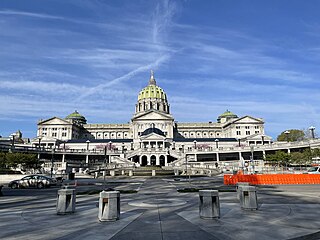
The Pennsylvania State Capitol is the seat of government for the U.S. state of Pennsylvania located in downtown Harrisburg which was designed by architect Joseph Miller Huston in 1902 and completed in 1906 in a Beaux-Arts style with decorative Renaissance themes throughout. The capitol houses the legislative chambers for the Pennsylvania General Assembly, made up of the House of Representatives and the Senate, and the Harrisburg chambers for the Supreme and Superior Courts of Pennsylvania, as well as the offices of the Governor and the Lieutenant Governor. It is also the main building of the Pennsylvania State Capitol Complex.
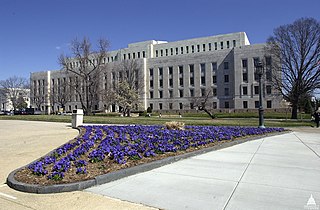
The John Adams Building is the second oldest of the buildings of the Library of Congress of the United States. Built in the 1930s, it is named for John Adams, the second president, who signed the law creating the Library of Congress in 1800. The building is in the Capitol Hill district of Washington D.C. next to the library's main building in the Capitol Complex. The Adams building opened to the public on April 5, 1939, and before being named for the president, it was long known as The Annex building. It is designed in a restrained but very detailed Art Deco style and faced in white Georgia marble. It is located on Second Street SE between Independence Avenue and East Capitol Street in Washington, DC.
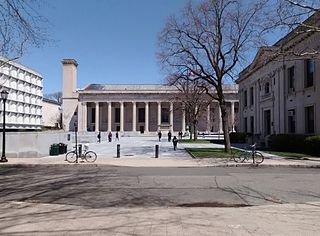
Hewitt University Quadrangle, commonly known as Beinecke Plaza, is a plaza at the center of the Yale University campus in New Haven, Connecticut. It is the home of the university's administration, main auditorium, and dining facilities. The quadrangle was created with the construction of the university's Bicentennial Buildings and Woodbridge Hall in 1901. Until 1917, it was known as University Court. The completion of the Beinecke Library created subterranean library facilities beneath the courtyard, establishing the present appearance of the paved plaza and sunken courtyard.

Solon Spencer Beman was an American architect based in Chicago, Illinois and best known as the architect of the planned Pullman community and adjacent Pullman Company factory complex, as well as Chicago's renowned Fine Arts Building. Several of his other largest commissions, including the Pullman Office Building, Pabst Building, and Grand Central Station in Chicago, have since been demolished. Beman designed numerous Christian Science churches and influenced the design of countless more.
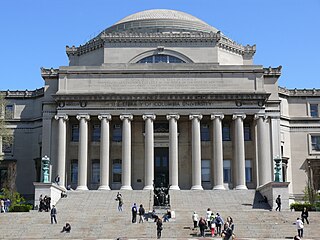
The Low Memorial Library is a building at the center of Columbia University's Morningside Heights campus in Upper Manhattan, New York City, New York, United States. The building, located near 116th Street between Broadway and Amsterdam Avenue, was designed by Charles Follen McKim of the firm McKim, Mead & White. The building was constructed between 1895 and 1897 as the university's central library, although it has contained the university's central administrative offices since 1934. Columbia University president Seth Low funded the building with $1 million and named the edifice in memory of his father, Abiel Abbot Low. Low's facade and interior are New York City designated landmarks, and the building is also designated as a National Historic Landmark.

T. B. Blackstone Memorial Library is a building that is part of the Chicago Public Library System and is named after Timothy Blackstone. The building was designed by Chicago architect Solon S. Beman. It is now known as the Chicago Public Library – Blackstone Branch and commonly referred to as Blackstone Library, or Blackstone Branch and sometimes Blackstone for short. The Concord Granite building's two-year construction started in 1902, and it was dedicated on January 8, 1904. Blackstone Library marks the beginning of the Chicago Branch Library System as the first dedicated branch in the system. Blackstone is also the only branch of the 79-branch Chicago Public Library branch system that was constructed using private funding. The Blackstone Library was designated as a Chicago Landmark.

Timothy Beach Blackstone was an American railroad executive, businessman, philanthropist, and politician. He is descended from William Blaxton, an early settler of New England. He worked in the railroad industry for most of his life after dropping out of school. At the time of his death, his estate was worth US$6 million.

The Chicago Federal Building in Chicago, Illinois was constructed between 1898 and 1905 for the purpose of housing the Midwest's federal courts, main post office, and other government bureaus. It stood in The Loop neighborhood on a block bounded by Dearborn, Adams and Clark Streets and Jackson Boulevard. The site held an 1880 post office, courthouse and customhouse which was cleared to make way for the new building. The 1905 building was itself demolished in 1965 and replaced with the Kluczynski Federal Building.

The Harris Museum is a Grade I-listed building in Preston, Lancashire, England. Founded by Edmund Harris in 1877, it is a local history and fine art museum.

The former First Church of Christ, Scientist in Forest Grove, Oregon, United States, is a historic Christian Science church built in 1916. It was designed by Spencer S. Beman, son of the noted designer of Christian Science churches, Solon Spencer Beman who had died in 1914. On January 21, 1994, it was added to the National Register of Historic Places.

The former First Church of Christ, Scientist, built in 1897, is a historic Neo-Classical-style church located at 4017 S. Drexel Boulevard in Chicago, Illinois. It was designed by noted Chicago-based architect Solon Spencer Beman, who was renowned for the churches and other buildings that he designed in the United States. In 1923 an Aeolian-Skinner organ was installed in the church. On May 7, 1950, Grant Memorial AME Church bought the building and is its present owner. First Church of Christ, Scientist, Chicago, is no longer in existence.

The Roswell P. Flower Memorial Library is a historic library building located in Watertown in Jefferson County, New York. The library was built in 1903 through 1904, and completed on November 10, 1904. The library opened on January 4, 1905. It was donated to the city by Emma Flower Taylor as a memorial to her father Roswell P. Flower (1835–1899), the 30th governor of New York. A genealogy department, local history collection and meeting rooms are inside the building. It also contains computers available for public use. The library serves as the primary library in Watertown and surrounding communities as a center for reading, culture and research. It was listed on the National Register of Historic Places in 1980.
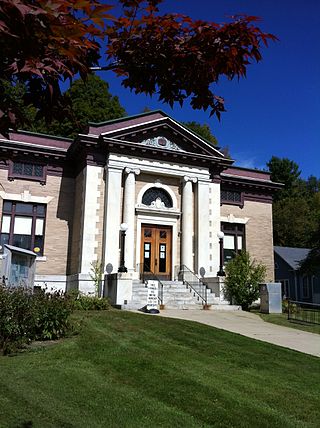
Ramsdell Public Library is one of two public library buildings of Great Barrington, Massachusetts. It is located at 1087 Main Street in the Housatonic village, in a two-story Beaux Arts building erected c. 1908. The building was a gift to the town by T. Ellis Ramsdell, fulfilling a bequest by his father Theodore, owner of the Monument Mills. It was designed by Boston architects McLean & Wright, with a sympathetic rear addition designed by the Pittsfield firm of Harding & Seaver. It was listed on the National Register of Historic Places in 2014.

The Edward L. Doheny Jr. Memorial Library is a library located in the center of campus at the University of Southern California (USC).

Ottumwa Public Library is a public library located in downtown Ottumwa, Iowa, United States. The current building was built in 1901. It is part of the Central Park area, which is the civic center of the community. It includes the Wapello County Courthouse, Ottumwa City Hall, and St. Mary of the Visitation Catholic Church. The library was listed on the National Register of Historic Places in 1984.
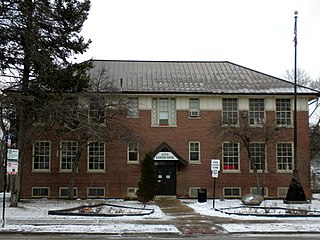
Edison Park is a park located in Edison Park community in Chicago, Illinois.
























